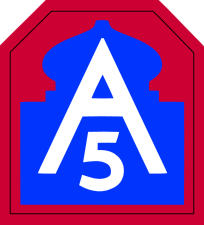
World War II
BAPTISM BY FIRE
What is now called U.S. Army North started life as the Fifth Army on 1 December 1942 in Oujda, French Morocco. Originally constituted of Army units that participated in Operation TORCH, the invasion of North Africa, it was the first of the seven field armies the United States organized during World War II.
On 12 December 1942, the new Fifth Army was assigned to the the multi-national Allied Force North Africa, and Lieutenant General Mark W. Clark wad designated its commanding general. At General Clark's direction, at one minute after midnight, Zulu Time, 5 January 1943, the Fifth Army became an active unit.
In North Africa, Fifth Army helped civil authorities maintain law and order in French Morocco and westerm Algeria, and organized, equiped and trained French forces in the area, no longer under Fascist control.
However, Fifth Army's primary mission was to prepare itself for the amphibious invasion of Italy. On 9 September 1943, Fifth Army landed an invasion force on a 20-mile strectch of beach south of Salerno, Italy, becoming the first American force to invade mainland Europe. At the time of the invasion, Fifth Army included the British X Corps, and the U.S. 36th, 45th and 82nd Divisions. This baptism by fire is celebrated as Fifth Army's Unit Day.
With the objective of capturing Rome, Fifth Army pushed northward from Salerno through Naples to the German line anchored on the town of Cassino. The French Expeditionary Corps, including Moroccan and Algerian divisions, joined Fifth Army, doubling its strength. After four costly assaults known as the Battles of Monte Cassino, the Fifth Army continued onward toward Rome, linking up on the way with other Fifth Army units that had fought their way out of the coastal town of Anzio.
Fifth Army entered Rome on 4 June 1944, becoming the first allied force to liberate a European capitol from Fascist control, although it did not capture the German forces that had held the city.
Two days later, the Normandy Invasion was launched. In support of that, one of Fifth Army's corps and the French Expeditionary Corps were withdrawn to participate in the invasion of southern France. To take their place, the 20,000-man Brazilian Expeditionary Force joined the Fifth Army.
Germans and Fascist Italians retreated north, turning and holding their ground at the Arno River. The pursuing Fifth Army reached the Arno on 18 July and finally crossed it on 2 September.
Now into their second winter in Italy, the Fifth Army got a new commander. General Clark assumed command of the 15th Army Group, composed of the Fifth Army and the British Eighth Army. Lieutenant General Lucian K. Truscott, Jr. became Fifth Army's commanding general on 16 December 1944, and served in that position to the end of the war.
By this time, Fifth Army had become a truly multi-ethnic command. Besides the Brazilians, there were British and French units whose members including New Zealanders, Canadians, Indians, Gurkhas, Jews and Arabs from the British Mandate in Palestine, South Africans, Rhodesians, Moroccans, Algerians and Sub-Saharan Africans. In smaller units were exiled forces from Poland, Greece, Czechoslovakia and anti-fascist Italians. From the United States itself came the segregated 92d "Buffalo" Division and the Japanese-American 442d Regimental Combat Team.
General Truscott led this multi-national Fifth Army out of its winter deadlock across the Italian Apennines and across the Po River valley. By the end of April, Fifth Army had reached the foothills of the Alps and had captured the cities of Bologna, Vicenza and Verona. On 29 April, American and British units entered Venice, and German representatives started negoations for surrender.
The battle for Italy came to an end on 2 May 1945, with the unconditional surrender of the German forces in Italy and the linkup between the Fifth Army and Seventh Army in the Brenner Pass.
From 9 September 1943 to 2 May 1945, Fifth Army endured 602 days of steady battlefield combat. This fighting resulted in 188,546 casualties among the 27 divisions and 7 corps that composed the Fifth Army. Fifth Army tied down at least 16 of Hitler's divisions and took 212,112 of his men prisoner.
Following Victory in Europe, 8 May 1945, Fifth Army's units were assigned away and the Headquarters became non-operational on 9 September – two years to the day after the landing at Salerno. Fifth Army was inactivated on 22 October 1945 at Camp Myles Standish, Massachusetts.
Chicago
IN THE ZONE OF THE INTERIOR (otherwise known as the US of A.)
Fifth Army was reactivated on 11 June 1946, with its headquarters in Chicago, Illinois, and later, at Fort Sheridan. It was one of the six field armies to be stationed in the continental United States. Its post-World War II function was the reduction and reorganization of the military units and installations in its area of responsibility, the north-central United States. As Fifth Army reduced its Active Component, it concurrently built up its Reserve Component.
Then as now, another responsibility of Fifth Army was to provide military to the nation in times of overwhelming natural disaster. In the winter of 1948-49, the Mid-West, particularly Nebraska, was hit by blizzards in November, December and January. State and local civilian relief organizations no sooner recovered from one storm when the next one hit. Even calling out the National Guard did not relieve the situation.
Fifth Army organized Operation SNOWBOUND, one of the U.S. Army's most extensive peacetime rescue operations, under the command of naming Major General Lewis A. Pick. Soldiers and equipment of the Fifth Army opened 87,073 miles of road, evacuated 152,196 persons from snowbound homes, and in conjection with the Air Force, provided feed for 3,500,000 head of livestock.
The start of the Korean conflict in the summer of 1950 gave a new emphasis and direction to Fifth Army's efforts. Fifth Army provided a steady flow of trained units and replacements to the U.S. forces in Korea, from the summer of 1950, to late 1952.
On 1 January 1957, Fifth Army, along with all the other field armies, added "United States" to their name, becoming "Fifth United States Army."
During the Berlin Crisis, 1961-1962, 85 of the Reserve units under Fifth U.S. Army, including the entire 32nd Infantry Division were called to active duty.
In early 1968, President Lyndon B. Johnson announced a limited mobilization of reserve component units. Of the 76 Army National Guard and U.S. Army Reserve units called to active duty, Fifth U.S. Army trained and mobilized 24 of them. All through the Vietnam War, Fifth U.S. Army units developed special training programs emphasizing skills needed to combat guerrilla warfare in tropical areas.
San Antonio
MOVE TO THE SOUTH
In the early 1970s, the areas of Fifth and the Fourth U.S. Armies were combined under a consolidated Fourth-Fifth Army command, to be headquartered at Fort Sam Houston, Texas. Several of the western states in both army areas were reassigned to Sixth U.S. Army, to the west.
On 30 June 1971, Fourth U.S. Army was inactivated, leaving Fifth U.S. Army's responsible for 14 states in the middle third of the United States, from Minnesota to Texas.
Following Iraq's invasion and occupation of Kuwait in 1990, President Bush gave the Secretary of Defense authorization to activate up to 200,000 members of the Reserve under the Total Force Policy. Once again, the Fifth Army was called upon to mobilize reserve component forces in support of Operations DESERT SHIELD and DESERT STORM. Fifth Army mobilized a total of 213 reserve units for deployment to Southwest Asia. By 30 September 1992, all but a handful of these units had redeployed and demobilized.
Fifth United States Army, throughout its 21-state area of responsibility, continued to provide training support and, on order, to mobilize reserve component forces to meet the requirements of combatant commands following the events of September 11, 2001. Fifth Army mobilized over 125,000 soldiers and 3,600 units in support of the Global War on Terrorism, and to free the people of Iraq.
HOMELAND DEFENSE
U.S. Army North (Fifth Army) is the Army component of U.S. Northern Command (USNORTHCOM), the combatant command established Oct. 1, 2002 to provide command and control of Department of Defense (DOD) homeland defense efforts and to coordinate defense support of civil authorities. ARNORTH’s mission is to conduct homeland defense, civil support operations and theater security cooperation activities. On order, U.S. Army North commands and controls deployed forces as a Joint Task Force or Joint Force Land Component Command.
Fifth Army Shoulder Sleeve Insignia

DESCRIPTIVE/BLAZON:
On a red rectangular background with top corners chamfered at 45° having a 2 1/2 inch (6.35 cm) base, 2 3/4 inches (6.99 cm) in height and top 1 3/8 inches (3.49 cm), a silhouette of a mosque in blue charged with a white letter "A" 1 9/16 inches (3.97 cm) in height, members 3/16 inch (.48 cm) in width above a white number "5", 11/16 inch (1.75 cm) in height, members 1/8 inch (.32 cm) in width.
SYMBOLISM:
The flag colors of red, white, and blue are self-explanatory. The outlined figure of the mosque is symbolic of the country in which Fifth Army, the previous designation of the unit, was originally activated. The letter "A" indicates "Army", and conforms in general, to designs used by the First and Third United States Armies.
BACKGROUND:
The shoulder sleeve insignia originally approved for Fifth Army on 26 January 1927, was pentagon shaped with a white background and five red stars formed in a pentagon shape. The current design was originally approved for Fifth Army on 7 April 1943. It was redesignated for the Fifth United States Army effective 1 January 1957. The insignia was redesignated for United States Army North with the description and symbolism updated on 19 December 2006.
Fifth Army Distinctive Unit Insignia

DESCRIPTIVE/BLAZON:
A device of silver color metal and enamel 1 1/4 inches (3.18 cm) in height overall consisting of a silver Florentine fleur-de-lis garnished with red buds and placed over the center of it a blue mosque tower with two silver stars on its base, two blue stars flanking its dome and a single blue star centered below it making a total of five stars positioned in the form of a "V"
SYMBOLISM:
The blue mosque is adapted from the US Army North shoulder sleeve insignia (formerly Fifth Army) and refers to the initial activation of the Headquarters, Fifth Army, in Morocco, North Africa, on 5 January 1943. The Florentine style fleur-de-lis denotes service in Italy and the five stars the number of campaigns to the Fifth Army's credit. The "V" form alludes to the unit's numberical designation.
BACKGROUND:
The distictive unit insignia was originally approved for Fifth United States Army on 31 October 1968. It was redesignated for United States Army North with the description and symbolism unpdated on 19 December 2006.